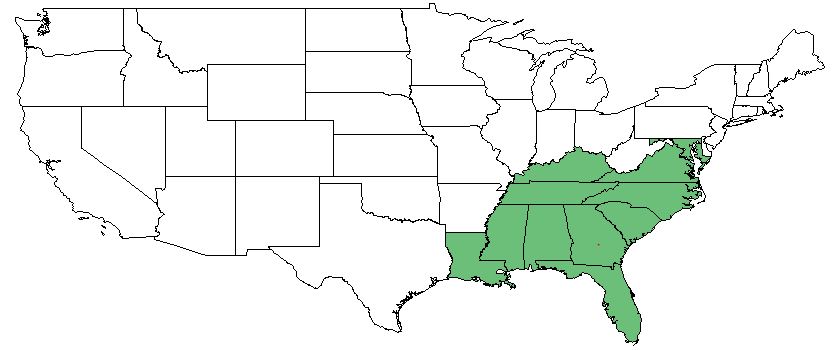Difference between revisions of "Dichanthelium tenue"
| Line 32: | Line 32: | ||
==Ecology== | ==Ecology== | ||
===Habitat=== <!--Natural communities, human disturbed habitats, topography, hydrology, soils, light, fire regime requirements for removal of competition, etc.--> | ===Habitat=== <!--Natural communities, human disturbed habitats, topography, hydrology, soils, light, fire regime requirements for removal of competition, etc.--> | ||
| − | ''D. tenue'' can be found in wet peaty or sandy soil in pineland savannas, flatwoods, bogs, and meadows. <ref name= "Weakley"> Weakley, A. S. (2015). Flora of the Southern and Mid-Atlantic States. Chapel Hill, NC, University of North Carolina Herbarium. </ref> More specifically, habitats range from hardwood forests, pine flatwoods and savannahs, shaded loams, along railroads and several other disturbed sites, sandy depressions and hills, scrub thickets, grass sedge bogs, and other flatwoods. <ref name= "Herbarium"> Florida State University Robert K. Godfrey Herbarium database. URL: http://herbarium.bio.fsu.edu. Last accessed: June 2018. Collectors: Loran C. Anderson, Cecil Slaughter, R. Kral, R. K. Godfrey, H. Kurz, S. W. Leonard, A. E. Radford, Sidney McDaniel, C. R. Bell, H. L. Blomquist, R. F. Thorne, and R. A. Davidson. States and counties: Florida: Wakulla, Liberty, Franklin, Levy, Alachua, Escambia, Lee, Calhoun, Madison, Pasco, Jefferson, Dixie, Martin, Bay, and Leon. Louisiana: St Tammany, and Ouachita. Georgia: Grady, Thomas, Clinch, and Baker. Alabama: Mobile. North Carolina: Wake, Pender, and Durham. Mississippi: Winston. South Carolina: Florence. </ref> | + | ''D. tenue'' can be found in wet peaty or sandy soil in pineland savannas, flatwoods, bogs, and meadows. <ref name= "Weakley"> Weakley, A. S. (2015). Flora of the Southern and Mid-Atlantic States. Chapel Hill, NC, University of North Carolina Herbarium. </ref> More specifically, habitats range from hardwood forests, pine flatwoods and savannahs, shaded loams, along railroads and several other disturbed sites, sandy depressions and hills, scrub thickets, grass sedge bogs, and other flatwoods. <ref name= "Herbarium"> Florida State University Robert K. Godfrey Herbarium database. URL: http://herbarium.bio.fsu.edu. Last accessed: June 2018. Collectors: Loran C. Anderson, Cecil Slaughter, R. Kral, R. K. Godfrey, H. Kurz, S. W. Leonard, A. E. Radford, Sidney McDaniel, C. R. Bell, H. L. Blomquist, R. F. Thorne, and R. A. Davidson. States and counties: Florida: Wakulla, Liberty, Franklin, Levy, Alachua, Escambia, Lee, Calhoun, Madison, Pasco, Jefferson, Dixie, Martin, Bay, and Leon. Louisiana: St Tammany, and Ouachita. Georgia: Grady, Thomas, Clinch, and Baker. Alabama: Mobile. North Carolina: Wake, Pender, and Durham. Mississippi: Winston. South Carolina: Florence. </ref> It is also a characteristic species of the panhandle silty longleaf woodlands and the upper panhandle savannas in Florida.<ref name= "Carr">Carr, S. C., et al. (2010). "A Vegetation Classification of Fire-Dependent Pinelands of Florida." Castanea 75(2): 153-189.</ref> |
Associated species: ''Dichanthelium aciculare'', ''D. ''acuminatum'', ''D. dichotomum'', ''D. ovale'', ''D. laxiflorum'', ''Polygonum pensylvanicum'', ''Sarracenia leucophylla'', ''Calopogon barbatus'', and ''Drosera'' sp.<ref name= "Herbarium"/> | Associated species: ''Dichanthelium aciculare'', ''D. ''acuminatum'', ''D. dichotomum'', ''D. ovale'', ''D. laxiflorum'', ''Polygonum pensylvanicum'', ''Sarracenia leucophylla'', ''Calopogon barbatus'', and ''Drosera'' sp.<ref name= "Herbarium"/> | ||
Revision as of 15:06, 2 May 2019
White-edged witchgrass
Contents
Taxonomic Notes
Synonyms: Panicum tenue Muhlenberg, Panicum albomarginatum Nash, Panicum trifolium Nash, Panicum ensifolium Baldwin, Panicum concinnius A.S. Hitchcock & Chase, and Dichanthelium dichotomum (Linnaeus) Gould var. tenue (Muhlenberg) Gould & Clark.
Varieties: none
Description
D. tenue, also known as white-edged witchgrass [1], is a native perennial with a graminoid growth habit that is a member of the Poaceae family. [2]
Distribution
The native distribution of D. tenue ranges in the gulf coastal plain from Louisiana up to Kentucky and Maryland. [2] The species is also present in Mesoamerica and Cuba. [1]
Ecology
Habitat
D. tenue can be found in wet peaty or sandy soil in pineland savannas, flatwoods, bogs, and meadows. [1] More specifically, habitats range from hardwood forests, pine flatwoods and savannahs, shaded loams, along railroads and several other disturbed sites, sandy depressions and hills, scrub thickets, grass sedge bogs, and other flatwoods. [3] It is also a characteristic species of the panhandle silty longleaf woodlands and the upper panhandle savannas in Florida.[4]
Associated species: Dichanthelium aciculare, D. acuminatum, D. dichotomum, D. ovale, D. laxiflorum, Polygonum pensylvanicum, Sarracenia leucophylla, Calopogon barbatus, and Drosera sp.[3]
Phenology
Flowering time of D. tenue ranges from May until October. [1] Fruit has been seen to be present in the months February through June, and September through November. [3]
Conservation and Management
This species is imperiled in Kentucky, vulnerable in Virginia, possibly extirpated in Delaware, and critically imperiled in New Jersey.[5]
Cultivation and restoration
Photo Gallery
References and notes
- ↑ 1.0 1.1 1.2 1.3 Weakley, A. S. (2015). Flora of the Southern and Mid-Atlantic States. Chapel Hill, NC, University of North Carolina Herbarium.
- ↑ 2.0 2.1 USDA Plants Database URL: https://plants.usda.gov/core/profile?symbol=DIDIT
- ↑ 3.0 3.1 3.2 Florida State University Robert K. Godfrey Herbarium database. URL: http://herbarium.bio.fsu.edu. Last accessed: June 2018. Collectors: Loran C. Anderson, Cecil Slaughter, R. Kral, R. K. Godfrey, H. Kurz, S. W. Leonard, A. E. Radford, Sidney McDaniel, C. R. Bell, H. L. Blomquist, R. F. Thorne, and R. A. Davidson. States and counties: Florida: Wakulla, Liberty, Franklin, Levy, Alachua, Escambia, Lee, Calhoun, Madison, Pasco, Jefferson, Dixie, Martin, Bay, and Leon. Louisiana: St Tammany, and Ouachita. Georgia: Grady, Thomas, Clinch, and Baker. Alabama: Mobile. North Carolina: Wake, Pender, and Durham. Mississippi: Winston. South Carolina: Florence.
- ↑ Carr, S. C., et al. (2010). "A Vegetation Classification of Fire-Dependent Pinelands of Florida." Castanea 75(2): 153-189.
- ↑ [[1]] NatureServe Explorer. Accessed: May 2, 2019
